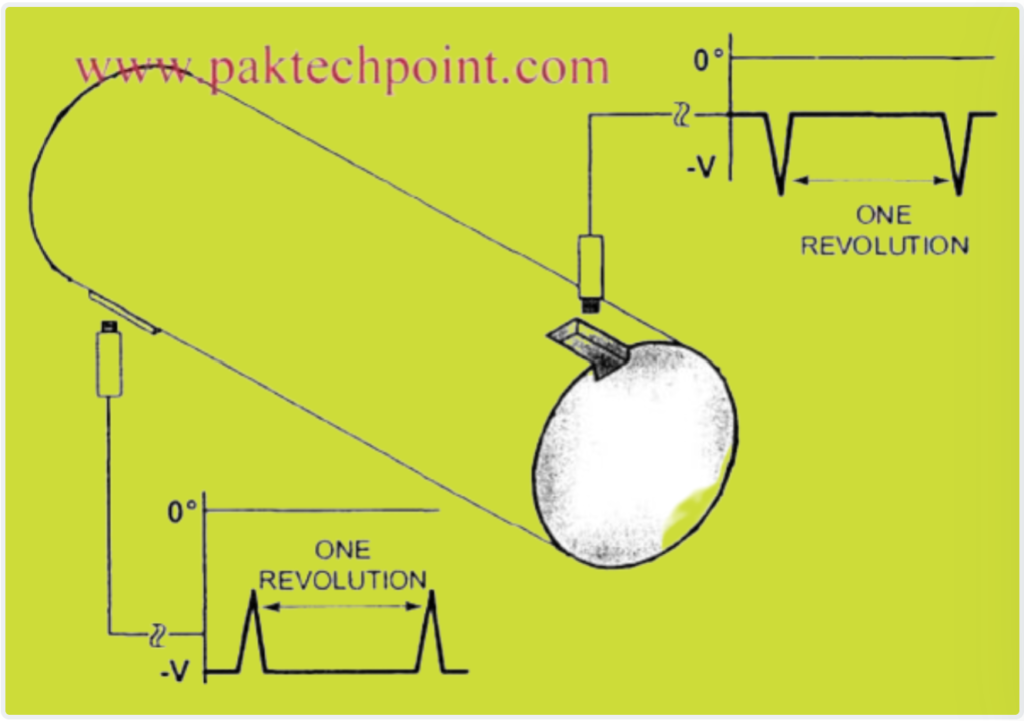What is
Defining Keyphasor in vibration system.
The Keyphasor is a transducer installed on machine traine, observing a once-per tum event on a rotating shaft providing a voltage pulse that occurs once per revolution of the shaft as shows in Fig. keyphasor measurement showing.

Fig . Keyphasor® Reference Signal
The keyphasor pulse provides a reference for data taken on a machine train. It is a reference mark and timer for speed, phase angle, frequency measurements and all balancing of machine rotor.
The keyphasor transducer is usually a proximity probe mounted observing keyway or projection which provides a large change in gap in front of the proximity probe. Since the proximity probe is a gap to voltage transducer, when the keyway passes the probe a voltage pulse results. Since the keyway passes the probe once-per-revolution of the shaft, the keyphasor pulse occurs at a frequency equal to the speed of the machine. Therefore, its frequency is the same as the running speed of the machine.
Please read also: Vibration measurement basic paramters
Probe Installation of Keyphasor.
The Keyphasor proximity probes should be installed observing a notch or projection of sufficient size to create a large voltage pulse. It is not desirable to simply put a scratch mark on the shaft and expect the proximity probe to provide a large pulse. This pulse should be of sufficient magnitude (Normally greater then 5 volts peak-to-peak) to trigger the Z intensity axis of an osci1loscope and to trigger the
time base sweep of the oscilloscope, also to trigger a digital tachometer easily without fear of triggering the tachometer on noise.
When the Keyphasor pulse is input to the Z intensity axis on an oscilloscope, it provides a reference spot on the dynamic waveform and/or orbital pattern. This appears as a bright spot and blank. By determining which of these occurs first in time, in the time base mode of the oscilloscope, it is possible to determine the direction of the dynamic motion of the shaft on the orbital pattern. Also since the Keyphasor occurs at a frequency of once per revolution, we can determine basic frequencies present in a vibration waveform on an oscilloscope by simply counting the number of cycles of vibration per Keyphasor pulse. In complex waveforms, the basic frequencies can be determined by counting the number of peaks that occur between Keyphasor pulses.
Please read also: Basic concept of vibration monitoring system
Assuming there is no gear in a particular machine train, it is necessary to have only one Keyphasor probe mounted on the driver of the machine train. Machine trains that have different speeds (gear increaser or reducer) must have more than one Keyphasor in order to meet the qualification that the Keyphasor pulse occurs at a frequency equal to once-per-revolution or lx rpm of the running speed of the machine.
It is desirable to have the Keyphasor probe installed on the driver on the machine train, since it is not uncommon to run the driver uncoupled from the load (for example, steam turbine drive). If the Keyphasor probe were located on the driven equipment, then the uncoupled run would be without the Keyphasor reference pulse.
Mount Keyphasor probes radially, not axially. Axial (thrust) movement may cause excessive voltage changes at the proximitor output, inhibiting proper keyphasor pulse amplitude. Observe a notch or projection of sufficient size to create a large voltage pulse. Bently Nevada recommends that proximity probe observe a notch or projection of 4140 materials.
The pulse should then be at least 5 volts peak-to-peak. Mount the keyphasor probe on the driver of the machine train. This will allow the driver to be run while uncoupled from the load.
Mount one (1) Keyphasor probe per each machine speed. If a gear increaser or reducer is used, two (2) Keyphasor probes are recommended, one on each side of gear box.
Please read also: Vibration Rod drop measurement
Size of Notch Or Projection
Length => two probe tip diameters.
Depth => 0.060 inch.
Width =>1.5 x the probe tip diameter.
Summary of Keyphasor
A Keyphasor measurement pulse derived from a transducer installed on a machine train provides the timing and phase reference which is vital for diagnostics and balancing of a machine rotor. The Keyphasor helps to answer the question “what is happening at this point on the machine at the same time something is happening at another point on the machine?” By providing a common reference throughout a machine train. The Keyphasor is a tremendous tool for correlating instantaneous dynamic motion information. The Keyphasor is truly a necessity for anyone who must intelligently analyze the condition of rotating machinery. A permanently installed Keyphasor measurement is recommended for every major machine train in a plant.
Hi there! This is my first comment here so I just wanted to give a quick shout out and say I truly enjoy reading through your blog posts. Can you recommend any other blogs/websites/forums that deal with the same subjects? Thank you!
good article on vibration really thanks